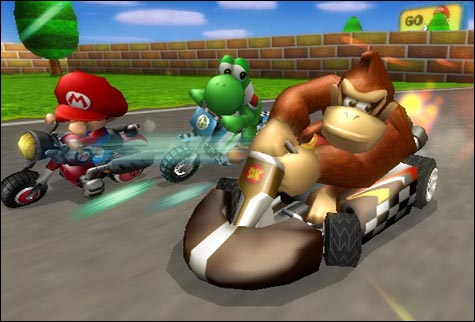
GIVING EVERYONE A CHANCE TO WIN: Running last? No problem: you get the devastating and unstoppable purple shell. |
Unless Nintendo is planning to drop a surprise Kid Icarus remake on us, Mario Kart Wii will be one of its last franchises to make the leap to the next generation. On past consoles, Nintendo meted out the classic series as if we were in the midst of wartime rationing, but just 18 months into the Wii’s lifecycle we’ve already welcomed new Zelda, Metroid, and Super Mario titles. Mario Kart Wii follows the same formula: gameplay essentially unchanged, even dumbed down a bit; gratuitous motion controls tacked on. The key difference in this case is that it all still works.
Like its predecessors, Mario Kart Wii is a racing game in which colorful Nintendo characters career around cartoonish tracks and fire a variety of goofy weapons at one another. Alongside old favorites like the homing red shell and the slippery banana peel are infuriating new attacks such as a squid that squirts ink all over the screen. Navigating the tracks well is often less important than deploying a helpful item at just the right time. One thing that can be maddening (or hilarious) about Mario Kart is the way it punishes the race leader, allowing him only defensive items while according the last-place contestant things like the devastating and unstoppable purple shell.
The point is to give everyone a chance to win. Down-to-the-wire finishes are common both in single-player and multi-player, regardless of player skill. Mario Kart Wii goes farther than most games to ensure that novice players don’t feel overmatched. Advanced players can take advantage of a gameplay mechanic called drifting that allows vehicles to slide around turns. If you drift long enough, you’ll get a speed boost. But there’s also the option to drift automatically; this one eliminates the boost, but it allows beginners to keep up with the action.
Also helpful for beginners is the much-touted Wii Wheel. The Wheel, which comes bundled with the game, seems at first like a cheap piece of plastic. All right, it is just a cheap piece of plastic. The Wii Remote snaps into it horizontally, and then you control your kart by turning the Wheel. The Wheel doesn’t allow you to steer quite as precisely as does an analog stick (which you can also use, by plugging in either the Classic Controller or a Gamecube pad), but it’s more than functional, and much more comfortable than it first appears.
Because this is a Wii game, there are, of course, reasons to shake the controller like an excited chimp. When a kart goes airborne, waggling the Wii Remote will cause the character to do a stunt, and that translates into a speed boost upon landing. When a character is riding a motorcycle, you can get a boost by waggling the Remote to pop a wheelie. The benefits of motion control are dubious when there isn’t at least some correlation to the events on screen, but developers crossed the Rubicon on this one long ago.
Many of the courses walk the line between “goofy fun” and “way the hell too much going on here.” A roller-coaster-like mine level is a blast; a volcano replete with fireballs and shifting plate tectonics starts to seem excessive. In addition to 16 new tracks, the developers have included another 16 from prior Mario Kart games, as a kind of greatest-hits collection. It’s hard to tell whether this is humble fan service or a cheap way to double the number of tracks without doing too much work. Despite Mario Kart’s effortless appeal, you might wonder the same thing about the whole game.